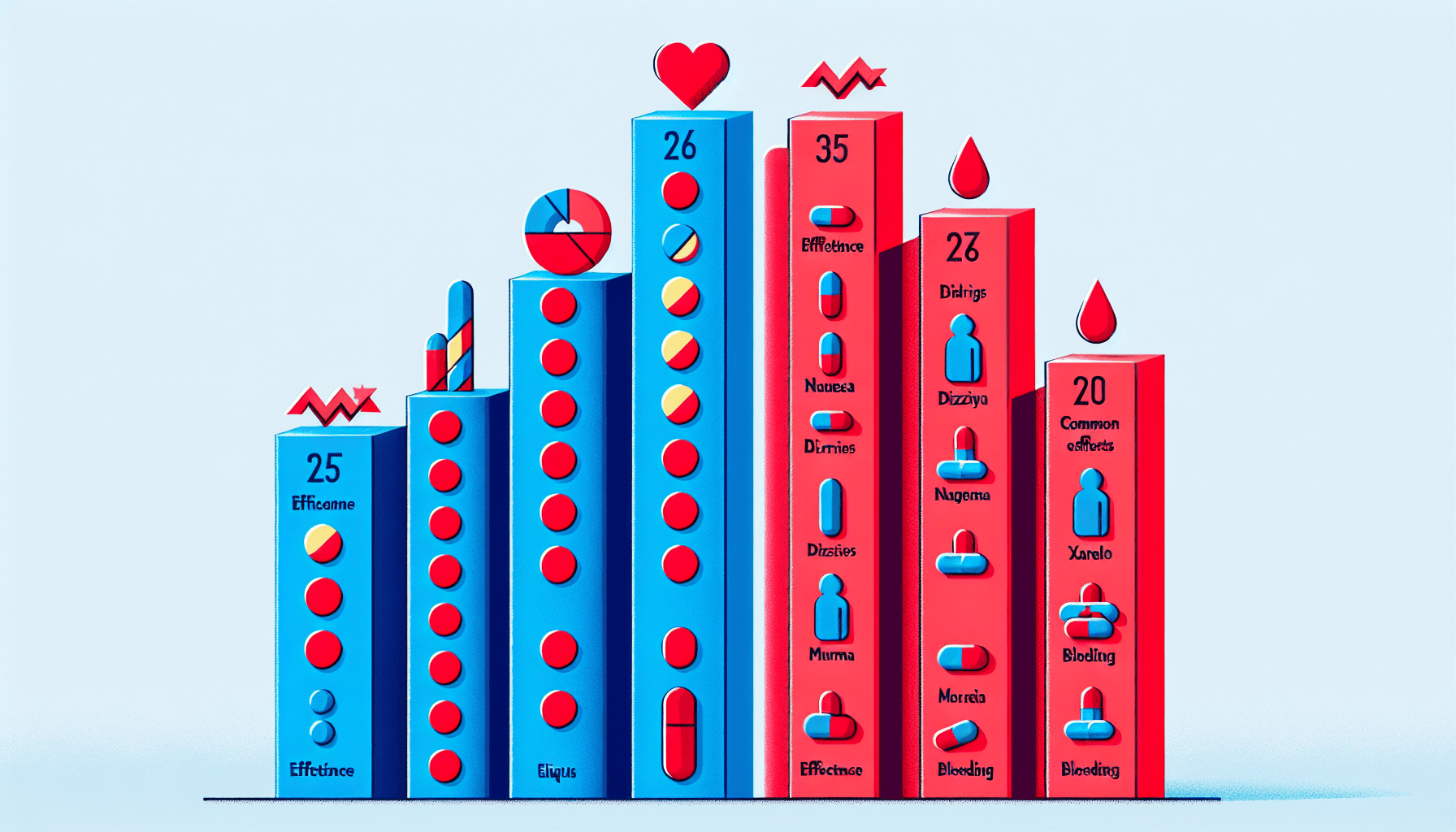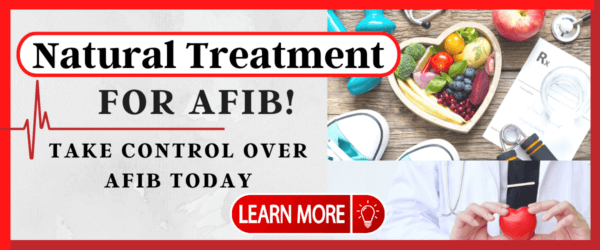Debating the merits of Eliquis vs Xarelto? We’ve got you covered. This head-to-head comparison unpacks their relative effectiveness, potential side effects, dosing schedules, and costs—equipping you with the information needed to navigate your healthcare choices confidently.
Key Takeaways
- Eliquis and Xarelto are both Factor Xa inhibitors with differences in usage, dosing guidelines, and patient populations, with Xarelto having pediatric indications, unlike Eliquis.
- Studies show that while both medications are effective, patients on Xarelto may have slightly higher risks for ischemic events and major bleeding than those on Eliquis, with varied effects in different patient populations.
- Eliquis and Xarelto have associated side effects, drug interaction profiles, and require careful dosage and administration, involving consultation with healthcare providers, especially when considering switching between the two.
Eliquis and Xarelto: Overview and Usage
Eliquis and Xarelto are both direct acting oral anticoagulants that serve to prevent and treat blood clots by blocking a clotting factor known as Factor Xa. In doing this, they obstruct thrombin formation, a substance vital to the clotting process. This decreases the production of clots and reduces the risk of conditions such as stroke and pulmonary embolism. The primary uses for both medications include preventing blood clots due to atrial fibrillation, blood clots following hip or knee replacement surgery, and treating and preventing deep vein thrombosis (DVT) and pulmonary embolism (PE).
While they share some common ground in terms of usage and mechanism of action, there are key differences between Eliquis and Xarelto. These differences lie in their:
- Active ingredients
- Specific uses
- Dosing guidelines
- Patient populations
Notably, Xarelto has additional indications for use in children and adolescents, unlike Eliquis. It’s important to weigh these distinctions when choosing between these two blood thinning drugs.
What is Eliquis?
Eliquis, scientifically known as apixaban, is a blood thinner that operates by blocking a clotting factor known as Factor Xa, thereby preventing and treating conditions related to blood clots. Its primary use is for the treatment of blood clots and the prevention of strokes in patients with atrial fibrillation, a condition characterized by an irregular and often rapid heart rate. It is also used for treating and preventing deep vein thrombosis (DVT) and pulmonary embolism (PE).
For individuals suffering from atrial fibrillation, the significance of Eliquis is undeniable. The medication serves to prevent stroke and systemic embolism, reducing the risk of unwanted blood clots that can lead to these severe conditions. It’s this ability to mitigate the stroke risks associated with atrial fibrillation that underscores the importance of Eliquis in the management of this condition, and the overall populatiry of the drug.
Eliquis received its initial approval from the U.S. Food and Drug Administration (FDA) in December 2012. The landmark trial leading to its approval was the ARISTOTLE trial, which included over 18,000 patients across 39 countries. The key results of this study demonstrated that Eliquis was superior to warfarin in preventing stroke or systemic embolism, caused less bleeding, and resulted in lower mortality overall.
What is Xarelto?
Xarelto, or rivaroxaban as it is scientifically known, parallels Eliquis in its role as a Factor Xa inhibitor. Through this mechanism of action, Xarelto successfully prevents and manages conditions associated with blood clots. It’s approved by the FDA for:
- Reducing the risk of stroke and systemic embolism in patients with nonvalvular atrial fibrillation
- Treating deep vein thrombosis and pulmonary embolism
The drug is also prescribed following knee or hip replacement surgery to prevent deep vein thrombosis (DVT), which can lead to pulmonary embolism (PE). Moreover, Xarelto is used to lower the risk of blood clots forming again after initial treatment, making it a vital player in the management and prevention of recurrent blood clot-related conditions.
Xarelto received its initial FDA approval in July 2011, following the pivotal ROCKET AF clinical trial, which involved over 14,000 patients from more than 45 countries. The trial was designed to compare the efficacy and safety of rivaroxaban (Xarelto) with warfarin in patients with nonvalvular atrial fibrillation. The key findings indicated that Xarelto was non-inferior to warfarin for the primary endpoint of preventing stroke and systemic embolism. Moreover, Xarelto showed a significant reduction in critical and fatal bleeding events compared to warfarin, alongside the advantage of not requiring routine blood monitoring.
Comparing Effectiveness: Eliquis vs. Xarelto
When summarizing the limited research studies that have compared the effectiveness and risks of Eliquis versus Xarelto, it’s important to emphasize the type of study and the quality of data. Key studies include the ARISTOTLE trial for Eliquis and the ROCKET AF trial for Xarelto, both of which were large, randomized, controlled trials (RCTs) providing high-quality data. The ARISTOTLE trial showed that Eliquis was superior to warfarin in preventing stroke or systemic embolism, caused less bleeding, and resulted in lower mortality overall. On the other hand, the ROCKET AF trial indicated that Xarelto was non-inferior to warfarin for preventing stroke and systemic embolism, with a significant reduction in critical and fatal bleeding events compared to warfarin.
Subsequent meta-analyses and observational studies have compared Eliquis vs Xarelto, and have provided additional insights but come with limitations due to potential biases and confounding factors inherent in these study designs. These studies suggest a slightly higher risk of ischemic events and major bleeding for patients on Xarelto compared to those on Eliquis, though results can vary across different patient populations.
Overall, while both medications are effective, the choice between Eliquis and Xarelto may be influenced by individual patient characteristics and clinical judgment, taking into account the quality and scope of available research data. Also, prescription coverage and costs options with a patient’s insurance plan may also influence which medication is selected.
Side Effects: Eliquis vs. Xarelto
Like all medications, Eliquis and Xarelto come with their own set of side effects. Common Eliquis side effects include bruising, nausea, anemia, and minor bleeding such as nosebleeds. On the other hand, common side effects of Xarelto involve back pain, bleeding gums, bloody stools, dizziness, headache, increased menstrual flow, leg weakness, and nosebleeds.
The potential for serious side effects also exists with both medications. Eliquis may cause severe allergic reaction and major bleeding complications. Similarly, Xarelto can lead to major bleeding events and allergic reactions.
The risk of bleeding increases with age, especially in the case of Xarelto, while Eliquis shows less of an age-related increase in bleeding risk.
In addition, Eliquis can cause gastrointestinal issues heightened by alcohol consumption and, rarely, thrombocytopenia. Xarelto might cause painful urination, blistering skin, chest tightness, gastrointestinal symptoms, and muscle spasms among its additional side effects. Considering these potential side effects and discussing them with your healthcare provider is vital when deciding on the medication to use.
Although both medications have a similar mechanism of action, I have had several patients who have had side effects to either Eliquis or Xarelto and then tolerate the other medication just fine.
Dosage and Administration
Correct dosage and administration are pivotal when it comes to anticoagulant medications. Strict adherence to the specific dosing guidelines for both Eliquis and Xarelto is essential to guarantee their efficacy and safety. These guidelines may vary depending on individual patient characteristics and other factors.
Eliquis Dosage Guidelines
Eliquis is generally taken orally at a standard dose of 5 mg twice daily, with or without food, and can be crushed and mixed with water, apple juice, or applesauce if needed. However, dosage adjustments may be required for certain patient groups. For patients over 75 years old, those with serum creatinine concentration ≥1.5 mg/dl, weight ≤60 kg, or other risk factors, a recommended dosage reduction to 2.5 mg twice daily is suggested.
Patients with severe chronic kidney disease or undergoing certain types of surgery may need a lower dose of Eliquis. Careful adherence to the prescribed dosage of Eliquis is crucial, as abrupt changes can worsen conditions, and higher dosages increase the risk of side effects. However, taking a dose that is lower then the recommended dose for a person’s age or weight could increase risk for blood clots or stroke.
Eliquis is not recommended for patients with mechanical heart valves, as its safety and efficacy have not been established for this particular group. For patients with liver impairment, Eliquis dosage adjustment recommendations vary by the severity of liver disease.
Xarelto Dosage Guidelines
Xarelto is available in 10 mg, 15 mg, and 20 mg tablets. For the management of nonvalvular atrial fibrillation, the typical dose is 20 mg taken once daily with the evening meal to ensure proper absorption. A dose of 15 mg daily is the adjusted dose for patients with renal impairment.
For other indications, such as the prevention of venous thromboembolism (VTE) in patients undergoing knee or hip replacement surgery, a lower dose of 10 mg once daily may be prescribed.
For the treatment of DVT or PE, Xarelto is typically prescribed as 15 mg twice daily for the first 21 days, followed by 20 mg once daily dosing.
If a patient is unable to swallow Xarelto tablets whole, the medication can be crushed and mixed with applesauce for immediate consumption; this mixture, however, is not suitable for storage for future use.
When transitioning patients from warfarin to Xarelto, discontinue warfarin and start Xarelto as soon as the international normalized ratio (INR) is below 3.0. If converting from Xarelto to warfarin, Xarelto treatment should overlap with warfarin until the INR is in the therapeutic range. If switching patients from anticoagulants other than warfarin, discontinue the other anticoagulant and start Xarelto 0 to 2 hours before the time that the next scheduled administration of the other anticoagulant would be due.
Drug Interactions
Both Eliquis and Xarelto interact with numerous other medications, which can increase the risk of bleeding or affect the effectiveness of the blood thinner. Drug interactions are classified as:
- Major: highly clinically significant and typically requiring the avoidance of the combination
- Moderate: may require dose adjustments or close monitoring
- Minor: may cause minimal or no clinical significance
Fortunately, both Eliquis and Xarelto have significantly less medication interactions when compared to an older generation blood thinner, warfarin.
It is important to consult with your healthcare provider or pharmacist to ensure that any medications you are taking do not interact with Eliquis or Xarelto.
Xarelto has a total of 363 known drug interactions categorized as 124 major, 231 moderate, and 8 minor, while Eliquis has 368 known drug interactions broken down into 120 major, 240 moderate, and 8 minor.
Common medications checked for interactions with Xarelto include amiodarone, amlodipine, aspirin, atorvastatin, furosemide, gabapentin, hydrochlorothiazide, levothyroxine, and lisinopril.
For Eliquis, commonly checked medications for interactions are albuterol, allopurinol, amiodarone, amlodipine, aspirin, atorvastatin, carvedilol, furosemide, gabapentin, and hydrochlorothiazide.
The possible drug interactions highlight the need for discussing all medications, supplements, and over-the-counter products with your healthcare provider before initiating treatment with Eliquis or Xarelto. It’s also crucial to remember that before trying new medications or natural remedies for blood thinning, it’s important to consult with a healthcare provider to ensure safety and avoid any interference with prescription drugs.
Cost and Insurance Coverage
Cost is another major factor to consider when choosing between Eliquis and Xarelto. Without insurance, the average cost of Xarelto is $703, while Eliquis averages $780. Both medications can be very costly without insurance coverage. However, with a SingleCare coupon, Xarelto can be discounted to around $407 and Eliquis to approximately $473. Currently, there is an approved generic form of Eliquis, but it is not yet available for patient use in the United States. Xarelto does not have a generic form on the market.
Insurance plans typically cover both Xarelto and Eliquis, which can significantly reduce the out-of-pocket expenses for patients. However, the specific co-pay or coinsurance amounts depend on the individual’s insurance plan details. It’s always a good idea to check with your insurance provider for specific coverage information and potential cost savings.
Cost Saving Options for Eliquis
Managing medication costs is crucial for many patients, and for those prescribed Eliquis, there are several cost-saving options available. One of the primary ways to reduce out-of-pocket expenses is through Eliquis coupon copay cards, which can significantly lower the cost of each refill. Eligible patients can obtain an Eliquis copay card that offers substantial savings, potentially reducing their copay to as little as $10 for a month’s supply, subject to eligibility and terms and conditions.
Additionally, patients can reach out to the Eliquis support center at 1-855-ELIQUIS (1-855-354-7847) for assistance. The support center can provide information on navigating insurance coverage, understanding cost-saving opportunities, and finding answers to questions related to Eliquis.
Furthermore, the Bristol-Myers Squibb Patient Assistance Program is another valuable resource for those who are uninsured or underinsured. This program aims to provide Eliquis at little to no cost to eligible patients who meet certain income and insurance criteria. By exploring these options, patients can find financial relief and ensure that their treatment with Eliquis remains consistent and uninterrupted.
Cost Saving Options for Xarelto
For patients prescribed Xarelto, managing medication costs is also an important consideration, and there are several programs available to help reduce these expenses. One of the most accessible cost-saving options is the Xarelto coupon copay card, which can significantly decrease the amount patients pay out-of-pocket. Eligible patients may be able to reduce their monthly copay to a more manageable amount, and in some cases, this could be as low as $10 per month, depending on the terms and conditions of the program.
In addition to the copay card, patients can contact the Xarelto support center for assistance. By calling the support number at 1-888-XARELTO (1-888-927-3586), patients can receive help with navigating their insurance coverage, understanding their cost-saving opportunities, and addressing any questions or concerns related to their Xarelto prescription.
Another valuable resource is the Janssen CarePath Savings Program for Xarelto, also known as the Janssen Select program. It provides support with cost savings to patients and can offer Xarelto at little to no cost to eligible patients who meet certain financial criteria.
Patients interested in these savings programs should check their eligibility, as certain restrictions may apply. These programs may not be available to patients who are enrolled in Medicare, Medicaid, or other federally funded insurance plans. By exploring these options, patients can seek financial relief and ensure that their treatment with Xarelto is both affordable and consistent.
Using Canadian Pharmacies for Eliquis or Xarelto
For those looking for cost-effective options when filling prescriptions for Eliquis or Xarelto, ordering from Canadian pharmacies that ship to the United States can be a viable alternative. Many American patients turn to Canadian suppliers due to the significant price differences for medications.
These online pharmacies typically require a valid prescription from a healthcare provider, and it is important to ensure that the pharmacy is legitimate and licensed. Patients should also be aware of the legal and regulatory implications of importing prescription drugs from international sources. As such, it’s advisable to consult with a healthcare provider and verify the pharmacy’s credentials before proceeding with an order.
Switching Between Eliquis and Xarelto
Switching between Eliquis and Xarelto should be done under the supervision of a healthcare provider. When considering switching from Eliquis to Xarelto, it is imperative to consult with a healthcare provider and patients must be informed about any common or differing warnings related to these blood thinners.
The correct procedure for switching from Eliquis to Xarelto is as follows:
- Stop taking Eliquis at the time when the next dose is due.
- Start taking Xarelto immediately after stopping Eliquis, without overlapping the two medications.
- Be aware of the dosing schedule changes when switching from Eliquis (usually taken twice daily) to Xarelto (generally taken once daily), although some conditions may require a twice-daily regimen.
It is important to follow this procedure to avoid excessive anticoagulation and ensure a smooth transition between medications.
Special Considerations
While Eliquis and Xarelto are generally safe for most people, there are special considerations when using these drugs in certain patient populations, such as older adults and pregnant women. Discussing these considerations with a healthcare provider is crucial to ensure a safe and efficient treatment plan.
Eliquis in Older Adults and Pregnancy
The risk of side effects with Eliquis, such as kidney problems or bleeding disorders, may be higher in older adults. Eliquis may also be used during pregnancy only when clearly needed.
Breastfeeding is not recommended while using Eliquis, as it is unknown if the medication passes into breast milk.
Xarelto in Older Adults and Children
In patients 65 years or older with atrial fibrillation, the adjusted incidence rate of major ischemic or hemorrhagic events, including major bleeding events, was higher with Xarelto compared to Eliquis.
Xarelto is also FDA-approved for thromboprophylaxis in pediatric patients aged 2 years and older with congenital heart disease post-Fontan procedure, and for the treatment of VTE and reduction in the risk of recurrent VTE for pediatric patients from birth to less than 18 years old after at least 5 days of initial parenteral anticoagulant treatment.
Natural Alternatives: Exploring Options for Blood Thinning
While prescription blood thinners like Eliquis and Xarelto are rigorously tested and proven to be effective in reducing the risk of stroke and blood clots, particularly in conditions such as atrial fibrillation, some individuals may be curious about natural alternatives that have been traditionally believed to have blood-thinning properties.
It’s important to acknowledge, however, that these natural options are generally significantly less potent than prescription blood thinners and have not been studied extensively for stroke risk reduction in atrial fibrillation or other clinical conditions.
Natural substances that are sometimes considered for their blood-thinning effects include:
- Ginger – Known for its anti-inflammatory properties and potential to inhibit blood clot formation.
- Cayenne Pepper – Contains capsaicin, which may help to promote blood flow and reduce clotting.
- Garlic – Has been shown to have a mild anti-clotting effect by inhibiting platelet aggregation.
- Turmeric – The active ingredient, curcumin, may have anticoagulant properties.
- Vitamin E – Acts as an antioxidant and may help prevent blood clots by reducing platelet aggregation.
- Nattokinase – An enzyme derived from natto, a Japanese fermented soybean dish, which is believed to have natural blood-thinning effects by breaking down fibrin, a protein involved in clot formation.
Although these substances may contribute to a reduction in blood clotting, they are not substitutes for prescription anticoagulants, especially in patients with a high risk of stroke or those with established cardiovascular conditions. The efficacy of natural blood thinners in providing adequate stroke risk reduction has not been established in the context of atrial fibrillation, and they should not be relied upon as a primary AFib treatment strategy.
Before considering any natural alternatives, it is crucial to consult with a healthcare provider. The interaction between natural substances and prescription blood thinners can pose significant health risks, and a healthcare professional can provide guidance on safe and effective treatment options.
Additionally, lifestyle changes, such as maintaining a healthy AFib diet, engaging in regular physical activity, smoking cessation, and managing stress, can support cardiovascular health but should complement, not replace, medically advised treatment plans.
Summary
In conclusion, both Eliquis and Xarelto are potent anticoagulant medications that can effectively prevent and treat blood clots in a variety of conditions. However, they come with distinct characteristics regarding their effectiveness, side effects, dosages, and costs, all of which should be considered when choosing between these two blood thinners.
It’s essential to discuss these factors with a healthcare provider to make the most informed decision. While this guide provides a comprehensive overview, it’s no substitute for medical advice. Always consult a healthcare professional before making changes to your medication regimen.
Frequently Asked Questions
Which is better to take Eliquis or Xarelto?
Eliquis may be the better choice for preventing blood clots and stroke in adults with nonvalvular atrial fibrillation, some studies have indicated a better safety profile and improved outcomes with Eliquis.
Why do doctors prefer Eliquis?
Doctors prefer Eliquis because it has been proven to prevent more strokes, cause less bleeding, and reduce the risk of death compared to other treatment options like warfarin.
What is the best blood thinner with the least side effects?
The safest blood thinner with the least side effects among DOACs, including dabigatran and rivaroxaban, is apibaxan (Eliquis) according to a study published in the Annals of Internal Medicine.
What is the safest blood thinner for AFib?
The safest blood thinners for AFib include direct oral anticoagulants (DOACs) like Pradaxa, Xarelto, and Eliquis, as they are less likely to cause hemorrhagic stroke than warfarin and have other benefits, such as fewer drug interactions.
What is the main difference between Eliquis and Xarelto?
The main difference between Eliquis and Xarelto lies in their active ingredients, specific uses, dosing guidelines, and patient populations.
The Best Atrial Fibrillation Book
Your Complete Guide To AFib: The Essential Manual For Every Patient With Atrial Fibrillation
$15.95 (as of April 26, 2024 10:31 GMT -06:00 - More infoProduct prices and availability are accurate as of the date/time indicated and are subject to change. Any price and availability information displayed on [relevant Amazon Site(s), as applicable] at the time of purchase will apply to the purchase of this product.) The A to Z guide on everything you need to know about atrial fibrillation. Written by AFib expert Dr. Percy Morales MD. Over 120 pages of essential information on medications, procedures, and lifestyles modifications for AFib. Easy to read for every patient.
Shop AFib Products on Amazon
KardiaMobile 6-Lead Personal EKG Monitor – Six Views of The Heart – Detects AFib and Irregular Arrhythmias – Instant Results in 30 Seconds – Works with Most Smartphones - FSA/HSA Eligible

KardiaMobile 1-Lead Personal EKG Monitor – Record EKGs at Home – Detects AFib and Irregular Arrhythmias – Instant Results in 30 Seconds – Easy to Use – Works with Most Smartphones - FSA/HSA Eligible

Apple Watch Series 9 [GPS 41mm] Smartwatch with Storm Blue Aluminum Case with Silver Sport Band M/L. Fitness Tracker, Blood Oxygen & ECG Apps, Always-On Retina Display

Fitbit Sense 2 Advanced Health and Fitness Smartwatch with Tools to Manage Stress and Sleep, ECG App, SpO2, 24/7 Heart Rate and GPS, Shadow Grey/Graphite, One Size (S & L Bands Included)

OMRON - Complete Wireless Upper Arm Blood Pressure Monitor + EKG - Built-in Bluetooth Technology

Omron Hem 7361T Bluetooth Digital Blood Pressure Monitor with Afib Indicator and 360° Accuracy Intelliwrap Cuff for Most Accurate Measurements (White)

EMAY Portable ECG Monitor | Record ECG and Heart Rate Anytime Anywhere | Stand-Alone Device with LCD Screen and Storage | No Subscription Required

Samsung Galaxy Watch 6 44mm Smartwatch with HR Zones, Sleep Coaching, Heart Monitor - Graphite

Natural Rhythm Triple Calm Magnesium 150 mg - 120 Capsules – Magnesium Complex Compound Supplement with Magnesium Glycinate, Malate, and Taurate. Calming Blend for Promoting Rest and Relaxation.

Pure Encapsulations Magnesium (Glycinate) - Supplement to Support Stress Relief, Sleep, Heart Health, Nerves, Muscles, and Metabolism* - with Magnesium Glycinate - 180 Capsules





















![Apple Watch Series 9 [GPS 41mm] Smartwatch with Storm Blue Aluminum Case with Silver Sport Band M/L. Fitness Tracker, Blood Oxygen & ECG Apps, Always-On Retina Display #1](https://m.media-amazon.com/images/I/311xwtp4mFL._SL100_.jpg)
![Apple Watch Series 9 [GPS 41mm] Smartwatch with Storm Blue Aluminum Case with Silver Sport Band M/L. Fitness Tracker, Blood Oxygen & ECG Apps, Always-On Retina Display #2](https://m.media-amazon.com/images/I/41j+8AaUGsL._SL100_.jpg)
![Apple Watch Series 9 [GPS 41mm] Smartwatch with Storm Blue Aluminum Case with Silver Sport Band M/L. Fitness Tracker, Blood Oxygen & ECG Apps, Always-On Retina Display #3](https://m.media-amazon.com/images/I/41jIyxZitnL._SL100_.jpg)
![Apple Watch Series 9 [GPS 41mm] Smartwatch with Storm Blue Aluminum Case with Silver Sport Band M/L. Fitness Tracker, Blood Oxygen & ECG Apps, Always-On Retina Display #4](https://m.media-amazon.com/images/I/41IpNJERjCL._SL100_.jpg)
![Apple Watch Series 9 [GPS 41mm] Smartwatch with Storm Blue Aluminum Case with Silver Sport Band M/L. Fitness Tracker, Blood Oxygen & ECG Apps, Always-On Retina Display #5](https://m.media-amazon.com/images/I/31o17yhfYpL._SL100_.jpg)

















































